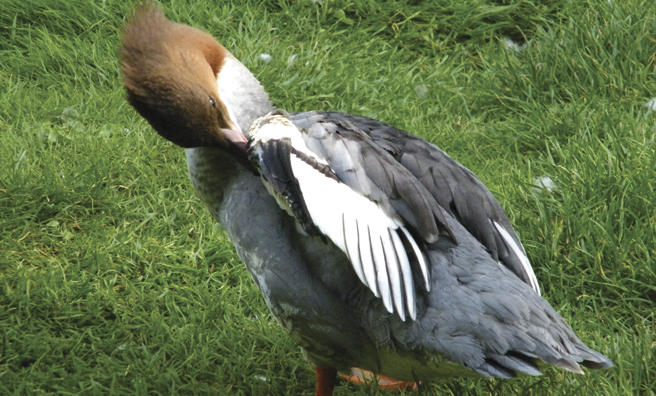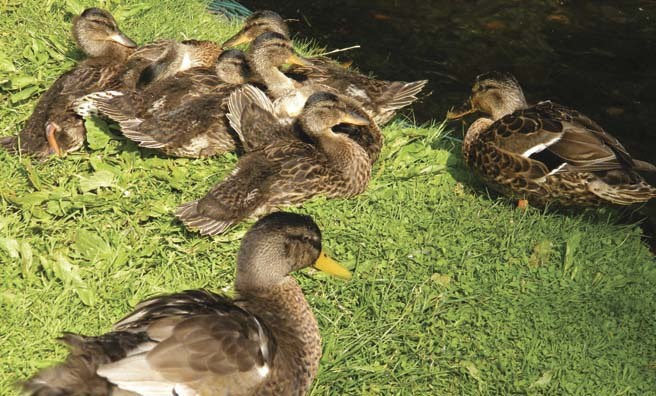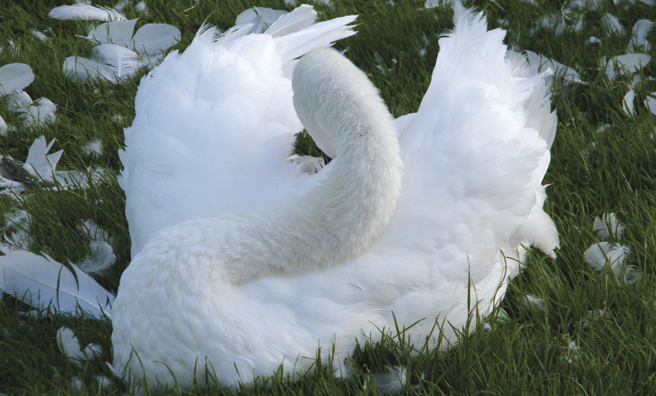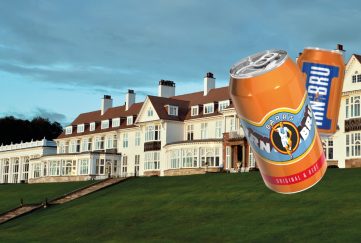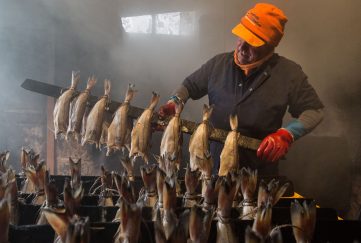Pond Life
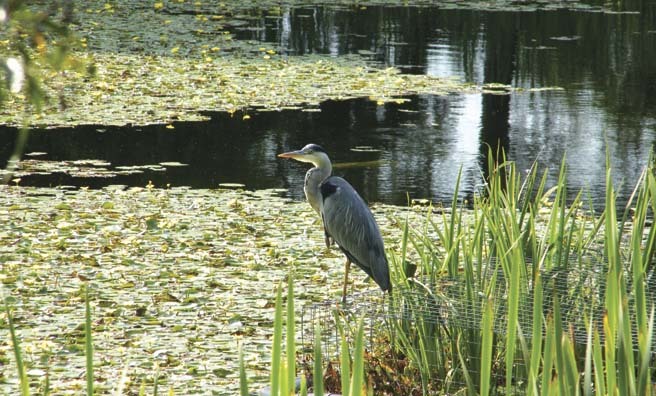
The pond is drowsy with high summer, too full with its own too-much-ness, the hallmark of the season.
Lowland Scotland always overdoes summer. It’s too green, too lush, too heavy-of-leaf, too insect-bedevilled, and generally too summery for my cool, north-inclining instincts. Nature, on the other hand, loves it.
The very surface of the water that was silvery or blue in spring is now thickly patched with green and yellow, a densely populated acreage of water lilies. One of the neighbourhood herons stands on the top of a low wire cage whose purpose I don’t quite understand, staring out over the water lilies as if it was wondering what to do about them, how to unravel their encumbrance, how to access open water and therefore fish. I have seen the heron occupy that perch before, in the same way that a heron of south Skye stands on a low rock as the tide begins to ebb out of Camuscross. But for the moment, this Lowland pond heron has no water to crouch over, so he stands in the sun and grows warm and presumably hungry.
Coots and moorhens force a passage the width of themselves through the water lilies, towing small flotillas of chicks behind them. I wonder whether they curse or bless the plants – bless because of the cover they provide (and the underwater growth is much too dense for the comfort of the neighbourhood pike that like to pluck chicks from beneath), or curse because anything like open water is a hundred yards away, and a hundred yards of this stuff is a wearying march for week-old chicks. More likely they just accept that that’s the way it is at this time of year and they get on with it.
A preening bird is both preoccupied and ill-equipped to avoid a quick strike
Most of the action is on the grassy verges. Many an inland water bird spends high summer getting rid of old feathers and acquiring new ones, which makes it a time of some vulnerability. Many predators, both mammal and bird, know all about flightlessness and the opportunities that go with it. A preening bird that is making a small rug of feathers on the bank is both preoccupied and ill-equipped to avoid a quick strike.
On the other hand, if you want to get close to wildfowl, now’s your chance. Here, for example, is a female goosander, unmoving over the last ten minutes, and so preoccupied in preening that she has not once looked at me or anything else in all that time. Her head, the characteristic deep chestnut red-brown of her tribe, is upside down while she preens her snowy breast and the innards of her starboard wing. There is an uncanny aspect to the markings on her blue-grey back that suggests shallow burn water rippling over rocks. The rest of her upper plumage is a lighter shade of the same undefinable colour, but there is a blaze of white on the wing bisected by a stripe of something like navy blue. There is also that fisher-bird’s long red beak and the vivid orange legs and feet, and neither shade goes with the ensemble at all, in the way that pink wellies don’t work with a Barbour.
A mallard duck and her six surviving ducklings (they were a brood of ten a few days ago) form a tight, nutty cluster on the very edge of the bank. They embody every shade of brown known to nature from almost black to palest fawn, and apart from half-hearted yellow bills and the adult’s stubby wing-flash of dark blue, no other colour at all.
They have one powerful ally whose company they ritually seek out – the swans
It all looks so vulnerable, what with the neighbourhood foxes and (more threatening by far) the frequent disobedience of dog-walkers’ dogs and the pike that lurk beyond the cloying water lilies to dispose of the more adventurous birds that can’t resist open water for long. But for as long as they linger on the bank, they have one powerful ally whose company they ritually seek out – the swans.
In midwinter, wildfowl cluster around swans because of their strenuous resistance to encroaching ice. Pools of open water stay unfrozen much longer when there are swans around, and the ducks know it. In midsummer, the sheer presence of swans is a blazing sunlit battery of ordnance more or less constantly primed to launch salvos of hissing intimidation and worse at dogs, cats, foxes, crows, big gulls, herons or anything else that even threatens to disturb the spectacular ritual of preening. The ducks know this too and will often stay within the swans’ force field for days at a time.
Half a dozen swans discard thousands of feathers during their annual moult
A preening swan makes summer blizzards on the banks. Half a dozen swans discard thousands of feathers during their annual moult, from tiny, miraculously curved neck feathers the size of your fingernail to primaries an eagle would not disown. Take hold of one of these by the end of the “quill” and swat the air with it near your other hand held open. Feel its power. Feel the air tremble against your open hand.
A huge bird like a mute swan wears an astounding assemblage of feathers, many thousands of them on a single bird. I have never heard of anyone who counted the number of feathers on a mute swan, but I have encountered a reference in a book called simply The Mute Swan by Mike Birkhead and Christopher Perrins which invited a startling implication:
“…people once counted those on a whistling swan. This bird, which weighed 6.1kg had 25,216 feathers, weighing 621g, one tenth of its total weight. Presumably mute swans, some of which are twice the weight of this bird, have even more feathers…”
If the implication of that equation is up to 50,000 feathers, the ritual that roots a single swan to the same spot for an hour or more at a time is more easily understood.
The result is a kind of vivid chaos
Sometimes they preen on water, sometimes standing on a submerged rock (a favourite stance of many wildfowl), and sometimes they sit on a warm grassy bank like this one and set about smothering its glowing midsummer greenery with feathered snow. If there is no wind, a bird creates a thickening circular island of white. If there is wind, and if there are several swans around, the result is a kind of vivid chaos.
Like most wildfowl, swans are flightless for a week or two during the moult, but in order to keep the full range of the bird’s powers intact if there are cygnets around, the cob and pen of a nesting pair will moult one at a time. And while flightless birds are disinclined to move very far, they remain prodigious swimmers, and even if they can’t get airborne, the sight of an adult cob threshing the water with feet and wings, neck held low over the water and dead straight, and if the whole thing is reflected on glass-still surface… that is nature designed to intimidate, and there is very little in the swans’ workaday world that cares to face it down.
Sea eagles are fazed by pretty well nothing at all
Except… that as it happens, these particular swans’ workaday world has just begun to change fairly dramatically, for this particular watersheet has just begun to attract the attention of a wandering sea eagle, and sea eagles, the swans and I are beginning to discover, are fazed by pretty well nothing at all.
Twice now I have seen one cross the pond’s airspace, and once perched on a spruce on a nearby hill. This could mean one eagle or three. As yet, I haven’t seen one make a bombing run on the natives of the pond, but I am only an occasional visitor here and I often wonder what gives when my back is turned.
Sea eagles are great wanderers in their young years, and it may be that their interest in the pond is a passing one, but as I slowly get to know them better it seems to me that where sea eagles turn up and disappear again, others of their tribe are inclined to follow. The trouble – and the undeniable fascination – for the nature writer is the unpredictability in his workaday world of this new and colossal presence that inhabits the upper echelons of nature’s food chain. For unlike the golden eagle, that specialist spirit of the high and lonely places, the sea eagle is a generalist, a jack of all trades and almost all landscapes. It does not shun the Lowlands, nor the artefacts and the presence of people.
People and wildlife have had to begin to make adjustments
In coastal Norway, where the Scottish population of reintroduced birds has been sourced, they are familiar around the waterfront edges of town and villages, perching on rooftops and pierheads, and walking the low tide sandbanks. Already, on places like Skye and Mull, people and wildlife have had to begin to make adjustments.
It remains to be seen whether birds from the east coast reintroduction project around the Tay estuary will establish the same kind of breeding presence, or whether they prefer the richer pickings and the company of an established breeding population of the West. After all, the first bird from the east coast project to breed did so, on Mull.
For the time being, there is a pond in the Lowland east where the natives, up to and including the swans, are looking a little nervously at this new shape in their sky, and while they have almost certainly never seen one before, the inherited history of all their tribes will have ensured that from the first moment of the first glimpse, they will have known exactly what it is.
And the too-fullness of summer has just got a lot fuller, and life there a lot more interesting.
- A female goosander preening
- Mallard and ducklings enjoy the sun
- A mute swan preening in a flurry of feathers
- A heron surveys its domain
Heron, Duck & Swan facts
- Herons have a wingspan of about 6ft but are a surprisingly light species, weighing around half as much as a goose
- Most herons nest in trees at least 25m above ground
- Mute swans have orange bills with black at the base
- Pairs of mute swans stay together for a breeding season but they often don’t mate for life
- Mallard ducklings mainly eat insects, only turning to a vegetarian diet as they get older
- As soon as the mallard ducklings hatch they take to the water and never return to the nest


